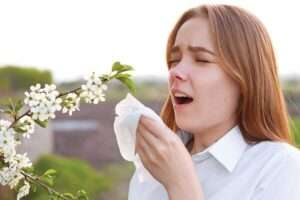By Cara Birrittieri
Author,Freelance Writer,Science Teacher,
CHQ County Resident
If you have noticed allergies arriving earlier than normal, you are not alone. In many parts of the country spring arrived early. That means those who suffer from seasonal allergies started feeling miserable early, and experts say this year may be a sign of things to come. Scientists and doctors are more concerned that seasonal allergies may continue to start earlier, last longer, and become more severe over the upcoming decades.
According to the National Phenology Network, parts of the Midwest, as well as New York, have seen record breaking timing, “Parts of the Southeast, lower Midwest, mid-Atlantic, and New York City area are seeing either the earliest spring leaf on record or a spring that only occurs once every 40 years.” Spring arrived nearly four weeks ahead of schedule in the Mid-Atlantic and Northeast this year.

of Michigan predicted that toward
the end of this century, pollen counts
could increase 200% if climate change
trends continue, thanks to warmer
temperatures and especially carbon dioxide
emissions. The Michigan study,
which ran various simulations, predicts
that pollen emissions could start
40 days earlier and last 19 days longer
than today.
Exactly when Spring begins is based on two parameters. One is the “first leaf index” and the other is the “first bloom index.” Both indexes rely on lilacs and honeysuckles, since they are both among the earliest plants to show their leaves and flowers. The Phenology Network says both are associated with the “first leafing” and “blooming of early spring shrubs and deciduous trees.”
Given such early first leaf and first bloom arrivals, those who are prone to seasonal allergies have likely felt their allergies kick in early as well, and such timing could mean the allergy season 2023 may be worse, and longer than usual. Of course, it’s the pollen that causes the allergic reaction, and pollen is key to the life cycles of all the flora we love so much in spring.
In fact, a study out of the University of Michigan predicted that toward the end of this century, pollen counts could increase 200% if climate change trends continue, thanks to warmer temperatures and especially carbon dioxide emissions. The Michigan study, which ran various simulations, predicts that pollen emissions could start 40 days earlier and last 19 days longer than today.
Pollen consists of tiny grains that contain the genetic material for plants to reproduce. These tiny grains are carried by air seeking plants of the same species to pollinate, and are inhaled easily. Many of us have an immune response to these intruders, kicking off a cascade of events inside our bodies. The immune system releases antibodies to attack the allergen/pollen, then histamines are released into the blood, which then triggers all your allergy symptoms: runny nose, sneezing, itchy eyes, etc.
Scientists believe how much pollen is released by grasses, trees, etc., depends on how well the plant grows. Many plants will grow more briskly with warmer temperatures, but plants also need carbon dioxide to thrive. Carbon dioxide powers photosynthesis, which produces the food and energy for the plant. The more access to carbon dioxide, the better plants will grow.
The Michigan researchers found that carbon dioxide may impact the levels of pollen even more than temperatures. Of course, excess carbon dioxide from carbon emissions of all sorts is what powers the greenhouse effect, and leads to rising temperatures. However, scientists admit they have no way to predict how plants will react to a tremendous rise in carbon dioxide.
Another 2021 study found that pollen levels have already risen substantially. Researchers at University of Wisconsin documented data from 1990 to 2018, which revealed that pollen season is about 20 days longer now, and actual pollen load is up 21%. If all this is giving you a headache and making you feel stuffed up, there is a bit of good news. Scientists are hopeful that keeping a much closer watch on climate, the springtime indexes, and pollen will provide much better accuracy for predicting pollen waves for allergy sufferers. Better predictions could help the roughly 30% of the population that are affected by pollen take cover, and start immediate treatment.
The Mayo Clinic says it’s best to keep a watch on weather reports, and stay indoors if pollen counts are high, avoid doing any kind of yard work, and if you go outside, wear a mask, then wash all clothes when you come in. Best of luck to everyone this season!
Check here for more info: https://www.mayoclinic.org/diseases-conditions/hay-fever/in-depth/seasonal-allergies
